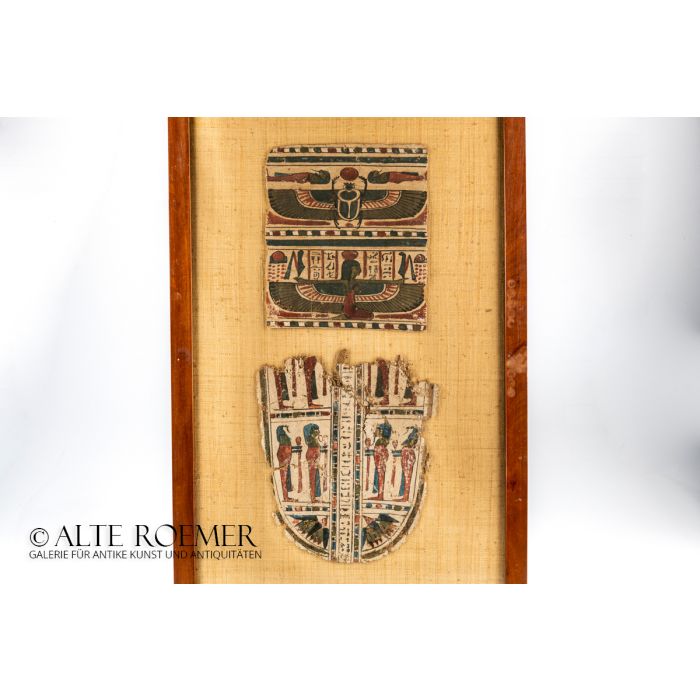Egyptian mummy cartonnage from Thebes
Price: on request
Sold
Object number
AR3085A
| Object: |
Two pieces of a mummy cartonnage from Thebes
|
| Material: |
Cartonnage made of gessoed and painted pieces of linen.
|
| Period: |
From Ptolemaic Egypt, approx. 3rd cent. BC to 2nd cent. BC. |
| Description: |
A set of two painted Egyptian cartonnage mummy trappings, one panel for the chest and the other for the legs. Both richly painted in the colours red, blue, green and black. White areas are represented by the background colour. The chest piece has a square outline, the leg piece a U-shaped one, both were deliberately cut out of the outermost mummy wrapping. The chest piece is divided into two horizontal image fields. Above the upper image field runs a somewhat broader dark blue band studded with stars. The leftmost star can be seen particularly well. Below the band hovers a winged scarab holding a solar disc between its front extremities. Above each of the two outstretched wings lies a mummy whose chin is adorned with a divine beard curved at the bottom. The image's message is clear: the deceased wants to be lifted up to heaven by Chepre, the divine apparition of the morning sun. The lower image field is dominated by the kneeling goddess Nut. She wears a sun disc on her head. Her arms spread a pair of wings and her hands each hold a feather of Maat and a flagellum. The borders beneath show a sun disc at the horizon, a symbol with the meaning "eternity" in ptolemaic hieroglyphs. The head of the goddess Nut is surrounded by two columns of text on each side, separated by thick lines. The four columns form a single short text formatted in italic scripture. It reads: Speaking words of Nut, the great, bearer of the gods, with substantial voice in Busiris: "He...". Busiris together with Abydos was the most important place of Osiris worship. The end of the text can't be deciphered with certainty. It is probably the beginning of direct speech that was not spelled out in entirety. The beginning of the direct speech was a place holder for the well known whole passage, like an incipit. The leg piece is divided into three image fields. The lower field is filled by two lotus flowers left and right. They are painted in some detail in green, blue and red colours. The centre field shows the four sons of Horus, left Qebehsenuef and Amset, right Duamutef und Hapi. The four persons in the upper field can't be attributed due to the missing heads and inscriptions. The long text column in the middle reads: [...] blessed, created by the mistress of the house Setja-irt-binet, blessed. To you comes Anubis, the embalmer, the master of the cemetery, so that he gives you a nice burial west of Thebes in Upper Egypt. The name of the owner is unfortunately lost. But the origin of this mummy cartonnage is clear: it is from the surroundings of the city of Thebes in Upper Egypt. |
| Dimensions: |
Chest piece 21cm x 18cm. Leg piece 24cm x 21cm. Modern wooden frame 67.5cm x 40.5cm.
|
| Condition: |
Two fragments with various chips, cracks and missing parts at the borders. However good overall condition for such a fragile artefact. The original gessoe and paint is still largely preserved on the linen substrate. The cartonnage fragments are mounted on a modern linen background and framed. The modern wooden frame is beginning to break down being several decades old. A sticker on its rear side informs that it has been made in a workshop in Paris, France.
|
| Provenance: |
Acquired by us in 2020 from S. Goenitzer, Austria. Exported in 2020 with permission of the Austrian Federal Monuments Office. Previously in the possession of Dr. Edmund Kupka, Austria. Acquired together with another mummy cartonnage in the 1960ies in Egypt, during his occupation at in international organization in Cairo. Exported to Austria in the 1960ies by Dr. Kupka. The original place of manufacture and certainly also the find spot is given by the long column of hieroglyphic inscription, it is the surrounding of the city of Thebes in Upper Egypt (modern Luxor). |
| References: |
The dating and interpretation of the mummy cartonnage was done in 2020 by Prof. Kurth, emeritus of Egyptology at Hamburg University, Germany. A publication of this cartonnage is planned for his upcoming book „Hausgrabungen, Band 3 (Aegyptiaca in deutschem Privatbesitz)".
|
| Literature: |
For diving deeper into Egyptian funerary literature and cult: Jan Assmann in Lexikon der Aegyptologie, Volume VI, pages 659-676.
|
| Authenticity: |
We unconditionally guarantee the authenticity of every artefact, all items are subject to our lifetime return policy on authenticity.
|


